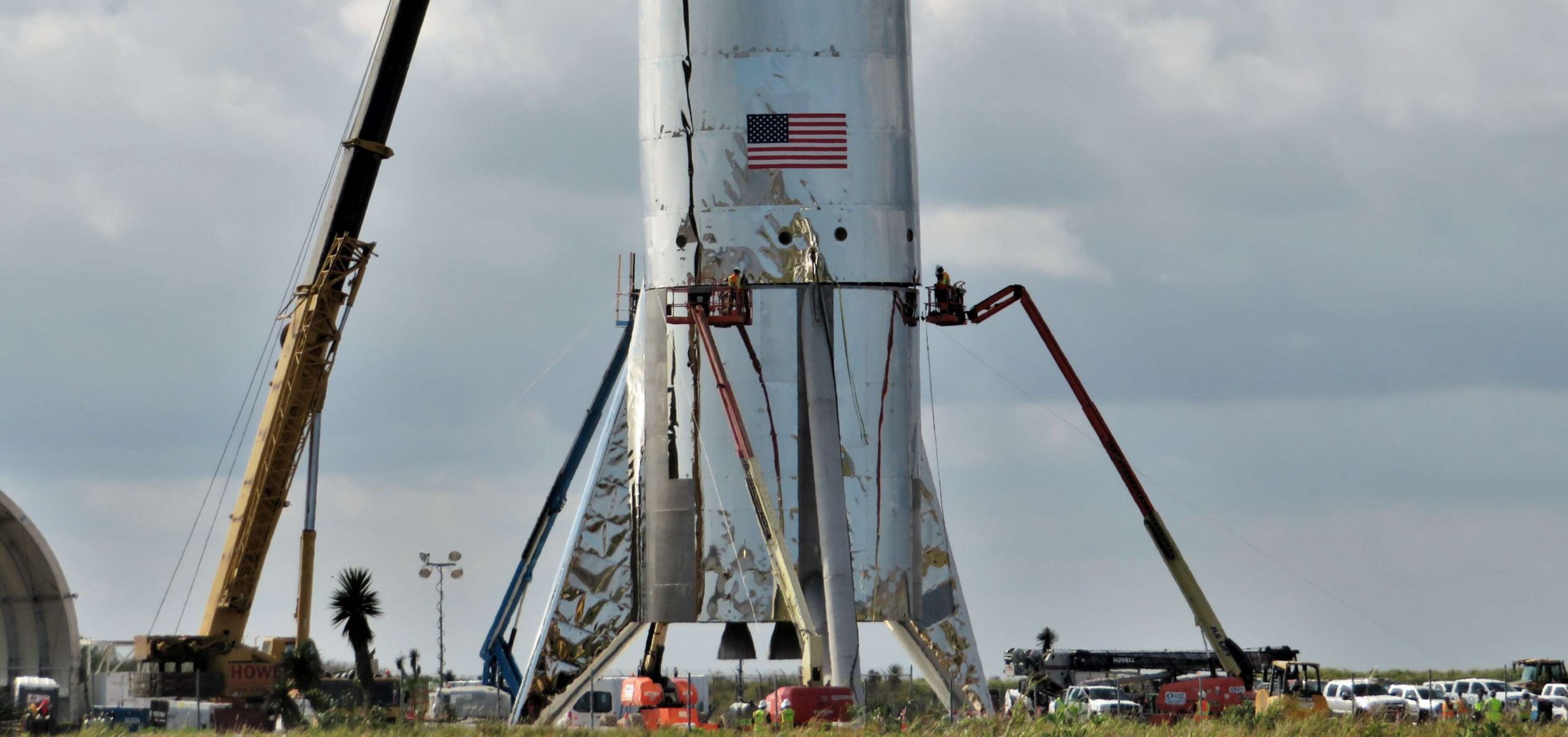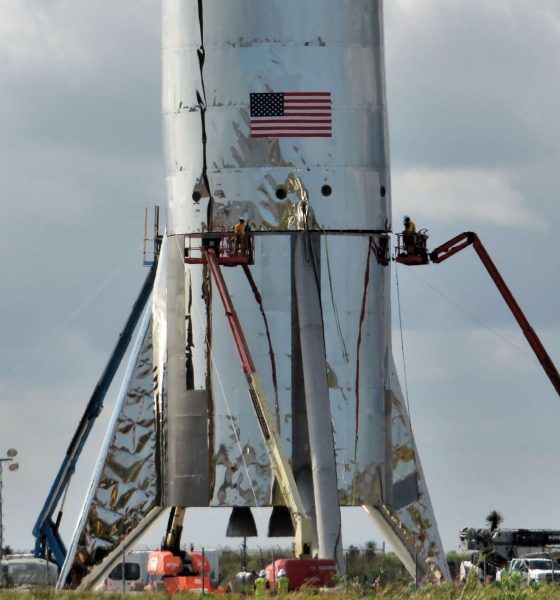

SpaceX
SpaceX’s Starship reaches new heights as Elon Musk teases Q1 2019 hop tests
In a burst of activity that should probably be expected at this point but still feels like a complete surprise, SpaceX technicians took a major step towards completing the first Starship hopper prototype by combining the last two remaining sections (aft and nose) scarcely six weeks after assembly began.
SpaceX CEO Elon Musk also took to Twitter late last week to offer additional details and post what appears to be the first official render of Starship’s hopper prototype, which is now closer than ever before to looking like the real deal thanks to the incredible drive of the company’s southernmost employees. With the massive rocket’s rough aeroshell and structure now more or less finalized, Musk’s targeted February/March hop test debut remains ambitious to the extreme but is now arguably far from impossible.
A quiet day as #SpaceX workers were having lunch and enjoying a well deserved break under the shadows of their creation. The wings/legs of the vehicle are getting an aesthetic touch up. 😍🚀 #Starshiphopper #ElonMusk #RGV pic.twitter.com/Y0zNGUNily
— Austin Barnard🚀 (@austinbarnard45) January 7, 2019
Where there was literally just a tent and some construction equipment barely eight weeks ago, SpaceX’s Boca Chica facilities now sport one of the most bizarre developments in recent aerospace history — a vast, ~30 ft (9m) diameter rocket being built en plein air out of tubes and sheets of common steel. At the current pace of work, 24 hours is often enough for wholly unexpected developments to appear, and this Starship hopper (Starhopper) is beginning to look more and more like its concept art as each day passes.
Aside from a few well-earned slow days last weekend, SpaceX technicians, engineers, and contractors have spent the last week or so shaping Starhopper into a form more reminiscent of the conceptual render (clearly hand-painted) Musk posted on Saturday. This primarily involved stacking a tall conical nose section atop a separate cylindrical body section, followed by gradually cladding both the aft section’s legs and barrel in sheets of stainless steel, presumably intended to improve both its aesthetic and aerodynamic characteristics.
Starship test vehicle under assembly will look similar to this illustration when finished. Operational Starships would obv have windows, etc. pic.twitter.com/D8AJ01mjyR
— Elon Musk (@elonmusk) January 5, 2019
SpaceX's Big Falcon Hopper/Starship Hopper at Boca Chica now has the three sections mated:#Shiny
Photo from NSF's BocaChicaGal:https://t.co/4RG5vZW4rN pic.twitter.com/Sd6W0Jepro
— NSF – NASASpaceflight.com (@NASASpaceflight) January 8, 2019
Notably, technicians have installed two out of three (?) aerodynamic shrouds at the top of each steel tube leg, bringing Starhopper’s appearance even closer to the smooth and polished aesthetic of its conceptual sibling.
Starhopper’s hopped-up hop test ETA
Musk later replied to a question related to Starhopper’s near-term schedule and stated that the nominal target for its first flight test was – almost unfathomably – four weeks away, although he admitted in the same response that that would probably translate into eight weeks due to “unforeseen issues”, placing the actual launch target sometime between February and March 2019. Just to reiterate, the site Starhopper is currently located on was quite literally empty – aside from the temporary tent – in late November 2018, barely more than six weeks ago.
Another great and beautiful day at #spacex today and progress is being made. I hope you all enjoy them, and have an amazing day.😃❤️🚀📸 pic.twitter.com/A9ukmdbgZI
— Austin Barnard🚀 (@austinbarnard45) January 5, 2019
To plan to go from a blank slate to actual integrated flight tests of a rocket – no matter how low-fidelity – that is 9m (~30 ft) in diameter, at least 40m (~130 ft) tall, could weigh as much as 500 tons (1.1M lbs), and may produce ~600 tons (~1.35M lb/f) of thrust at liftoff is extraordinarily ambitious even for SpaceX. At the end of the day, significant delays to Musk’s truly wild timeline are very likely, but it seems entirely possible at this point that Starhopper really could begin its first hop tests in the first half of 2019, kicking off a test program currently aiming for flights as high as 5 km (3.1 mi) and as long as 6 minutes.
A whole range of things will have to go perfectly right for a timeline as ambitious as this to be realized, including but not limited to successfully acceptance-testing three brand new and recently-redesigned Raptor engines, the completion of Starhopper’s unfamiliar structures, propellant tankage, plumbing, and avionics, and the completion of a rough launch and landing pad and integration facilities, if needed. Aside from those big ticket items, many dozens of other smaller but no less critical tasks will have to be completed with minimal to no unforeseen hurdles if hop tests are to begin just a few months from now.
And follow up from NSF member "bocachicagal"
Mating complete! 🙂 pic.twitter.com/LbR0PKENII
— NSF – NASASpaceflight.com (@NASASpaceflight) January 4, 2019
Regardless, SpaceX has pulled off miraculous tasks much like this in its past, and the possibility that the company’s brilliant, dedicated, and admittedly overworked employees will do so again should not be discounted.
For prompt updates, on-the-ground perspectives, and unique glimpses of SpaceX’s rocket recovery fleet check out our brand new LaunchPad and LandingZone newsletters!

Elon Musk
SpaceX issues statement on Starship V3 Booster 18 anomaly
The incident unfolded during gas-system pressure testing at the company’s Massey facility in Starbase, Texas.

SpaceX has issued an initial statement about Starship Booster 18’s anomaly early Friday. The incident unfolded during gas-system pressure testing at the company’s Massey facility in Starbase, Texas.
SpaceX’s initial comment
As per SpaceX in a post on its official account on social media platform X, Booster 18 was undergoing gas system pressure tests when the anomaly happened. Despite the nature of the incident, the company emphasized that no propellant was loaded, no engines were installed, and personnel were kept at a safe distance from the booster, resulting in zero injuries.
“Booster 18 suffered an anomaly during gas system pressure testing that we were conducting in advance of structural proof testing. No propellant was on the vehicle, and engines were not yet installed. The teams need time to investigate before we are confident of the cause. No one was injured as we maintain a safe distance for personnel during this type of testing. The site remains clear and we are working plans to safely reenter the site,” SpaceX wrote in its post on X.
Incident and aftermath
Livestream footage from LabPadre showed Booster 18’s lower half crumpling around the liquid oxygen tank area at approximately 4:04 a.m. CT. Subsequent images posted by on-site observers revealed extensive deformation across the booster’s lower structure. Needless to say, spaceflight observers have noted that Booster 18 would likely be a complete loss due to its anomaly.
Booster 18 had rolled out only a day earlier and was one of the first vehicles in the Starship V3 program. The V3 series incorporates structural reinforcements and reliability upgrades intended to prepare Starship for rapid-reuse testing and eventual tower-catch operations. Elon Musk has been optimistic about Starship V3, previously noting on X that the spacecraft might be able to complete initial missions to Mars.
Elon Musk
SpaceX Starship Version 3 booster crumples in early testing
Photos of the incident’s aftermath suggest that Booster 18 will likely be retired.

SpaceX’s new Starship first-stage booster, Booster 18, suffered major damage early Friday during its first round of testing in Starbase, Texas, just one day after rolling out of the factory.
Based on videos of the incident, the lower section of the rocket booster appeared to crumple during a pressurization test. Photos of the incident’s aftermath suggest that Booster 18 will likely be retired.
Booster test failure
SpaceX began structural and propellant-system verification tests on Booster 18 Thursday night at the Massey’s Test Site, only a few miles from Starbase’s production facilities, as noted in an Ars Technica report. At 4:04 a.m. CT on Friday, a livestream from LabPadre Space captured the booster’s lower half experiencing a sudden destructive event around its liquid oxygen tank section. Post-incident images, shared on X by @StarshipGazer, showed notable deformation in the booster’s lower structure.
Neither SpaceX nor Elon Musk had commented as of Friday morning, but the vehicle’s condition suggests it is likely a complete loss. This is quite unfortunate, as Booster 18 is already part of the Starship V3 program, which includes design fixes and upgrades intended to improve reliability. While SpaceX maintains a rather rapid Starship production line in Starbase, Booster 18 was generally expected to validate the improvements implemented in the V3 program.
Tight deadlines
SpaceX needs Starship boosters and upper stages to begin demonstrating rapid reuse, tower catches, and early operational Starlink missions over the next two years. More critically, NASA’s Artemis program depends on an on-orbit refueling test in the second half of 2026, a requirement for the vehicle’s expected crewed lunar landing around 2028.
While SpaceX is known for diagnosing failures quickly and returning to testing at unmatched speed, losing the newest-generation booster at the very start of its campaign highlights the immense challenge involved in scaling Starship into a reliable, high-cadence launch system. SpaceX, however, is known for getting things done quickly, so it would not be a surprise if the company manages to figure out what happened to Booster 18 in the near future.
Elon Musk
SpaceX’s next project will produce Starships at a level that sounds impossible
1,000 rockets per year is an insane number, especially considering Starship’s sheer size.

Elon Musk has revealed bold plans for SpaceX’s newest Starbase facility in Texas, predicting it will become a birthplace for “so many spaceships.” The upcoming “Gigabay,” a massive $250 million production hub in Starbase, Texas, is designed to manufacture up to 1,000 Starship rockets per year.
That’s an insane number of rockets for a single facility, especially considering Starship’s sheer size.
One of the world’s largest industrial structures
SpaceX’s Gigabay is expected to stand roughly 380 feet tall and enclose 46.5 million cubic feet of interior space, making it one of the largest industrial structures to date. The facility will feature 24 dedicated work cells for assembling and refurbishing Starship and Super Heavy vehicles, complete with heavy-duty cranes capable of lifting up to 400 U.S. tons, as noted in a Times of India report.
Construction crews have already placed four tower cranes on-site, with completion targeted for December 2026. Once operational, the Gigabay is expected to boost SpaceX’s launch cadence dramatically, as it would be able to build up to 1,000 reusable Starships per year, as noted in a report from the Dallas Express. Musk stated that the Gigabay will be “one of the biggest structures in the world” and hinted that it represents a major leap in Starbase’s evolution from test site to full-scale production hub.
A key step toward Mars and beyond
Starship is SpaceX’s heavy-lift rocket system, and it remains a key part of Elon Musk’s vision of a multiplanetary future. The vehicle can carry 100–150 tonnes to low Earth orbit and up to 250 tonnes in expendable mode. With several successful flights to date, including a perfect 11th test flight, the Starship program continues to refine its reusable launch system ahead of crewed lunar missions under NASA’s Artemis initiative.
Starship is unlike any other spacecraft that has been produced in the past. As per Elon Musk, Starship is a “planet-colonizer” class rocket, as the magnitude of such a task “makes other space transport task trivial.” Considering Starship’s capabilities, it could indeed become the spacecraft that makes a Moon or Mars base feasible.








